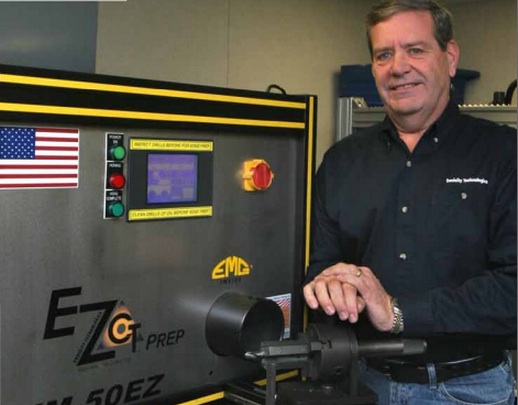In this interview, William Shaffer describes how his edge preparation machine addresses tool failure issues with an automated brush honing process.
William Shaffer, vice president of Conicity Technologies, Latrobe, Pa., worked as a machine designer for many years. In the 1990s he became curious about tool failure modes and developed an edge preparation machine for precisely forming a cutting edge to maximize tool life and efficiency. He called it Engineered Micro Geometry (EMG). His company, Conicity, was formed in 1999 in association with Weiler Corporation, Cresco, Pa., a manufacturer of the abrasive brushes used in the precision Conicity honing process.
What does EMG technology do?
Cutting tools live and die based on corner strength. EMG profiles the cutting edge so the edge-prepped area is thinner where the chip is thinner, strengthening the corner and reducing the rubbing that generates heat. Controlling the microgeometry of the cutting edge not only has significant effects on overall tool life and metal cutting efficiency, but also surface finish and the formation of burrs.
How did you develop the technology for EMG?
The idea of varying the edge preparation started out with my curiosity about why certain tools fail specifically due to heat. I made an extensive study of tool failures, starting in 1999.
The study began with a tool that has a trademark failure pattern: the plunge-style grooving tool. This tool fails more than 90 percent of the time due to heat, with the corners of the tool being “burned.” Typically, the center region of the cutting edge of the tool would still be intact after both corners had failed.
Once I identified the tool failure mode as edge prep rubbing, the next step was to control the distribution of the edge prep—keeping the edge prep in ratio with the chip being cut. The edge preparation process parameters were developed in late 1999 and the metal cutting testing began.
Our first edge preparation machine was introduced at IMTS in 2006. We now offer insert, round tool and drill preparation systems suitable for use on the shop floor. They use a precision, automated brush honing process to produce the correct edge profile.
What can your edge preparation machine do?
In one application, the PCD tools used for high-speed milling automotive heads lasted 80,000 heads. The failure mode was burr generation. We had the engineer take 18 tools out of the batch and edge prepped them. The shop then got 280,000 heads on a tool.
There isn’t a tool you can name that we haven’t improved: broaches, reamers, high speed steel tools, and other materials. We edge-prepped 2” broaches for a washing machine manufacturer. They ran eight times longer.
Can edge preparation help make dry machining more practical?
EMG allows the efficiency of the metal cutting process to remain at a high level. When metal cutting efficiency is up, forces are lower and heat generation is reduced. Once the source of heat is essentially controlled, then the advantage of the Micro- Geometry edge prep can be combined with correct substrates, different tool geometries, and high performance tool coatings, to allow dry cutting to become a more economical proposition for the industry.
What’s in store for the future of EMG?
The manufacturing sector and the environment’s demand for effective dry machining to help reduce pollutants will grow. EMG is already a key factor in that process.
Efficient machining of both new and existing aerospace materials will soon need to be at a much higher rate, too. In a few short years, the number of machines required to support global aerospace production will exceed the number of machines that exist. High speed machining of composites, reinforced plastics, and carbon fiber will become more and more important. EMG is already effectively functioning in these areas.
How can a machine shop use EMG technology?
Shops can lease or buy our machines. Models are available for forward-cutting tools (reamers, drills, gun drills) and side-cutting tools (end mills, taps, steps on step drills). There is a model specifically for inserts. The machines will do any material including carbide, cermet, PCD and CBN. To operate, you simply load the tool and consult a chart that tells which program to run, based on tool and process parameters.
On the drill edge prep machine, for example, you can run 100 tools per hour. The machine makes both cutting edges the same, which helps the drill track straight.
Is it good?
You bet. Game-on.
Today’s Machining World Archives January/February 2011 Volume 7 Issue 1

